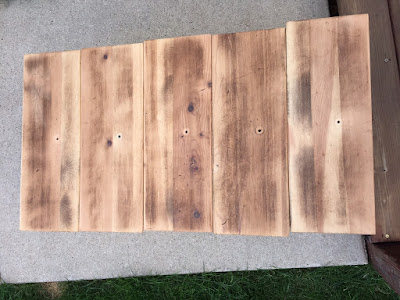Man, did I feel for this dresser who was totally hating life. They need loving homes too, so, I took him home.
First off, I scored big. This dresser needed serious help, but it was made of solid wood. I'm going to guess pine...? It made the whole sanding off paint-stain-combo really easy. In 30 minutes I had the dresser down to bare bones. Secondly, this dresser has ten drawers. Enough said.
After taking one look at this dresser I knew what I was going to do. West Elm is one of my favorites, as I'm sure it is for a lot of people, but sometimes the prices are not so much. I like the humor of their 'patchwork' furniture, but I'm all over here being cheap. So, I would do what any cheap person would do and that is to make the dresser different, but same same.
After getting the sanding bit done, I primed and painted the frame of the dresser, letting the drawers free ball it for a bit. My go-to white for a lot of furniture projects is White Dove by BM. The white is pure enough, but it also gives off this milky appearance, making it look rich and creamy.
One thing that makes these patchwork dressers so unique is the variance of stains that are used. As hard as I tried, the lightness of the wood could not illuminate a brighter shade as much as I sanded it. This meant some stain choices were totally out of the picture. However, I was able to use this helpful guide from Panyl to come up with additional options.
If you're bored, I would totally recommend that you check out their site too. Lots of valuable information in there, especially when it comes to modifying Ikea furniture.
Ten drawers should equal ten stains, right? When you are dealing with so many shades, keep in mind that similar shades should stay far away from one another, therefore considering the placement of your drawers before proceeding is a must.
As you can see above, Panyl does something really awesome. They have a color selector so you can visualize what the stains will look like when they are put together. No more ah shit moments.
I choose Ebony (a clear favorite in our house), Driftwood, Gray, Puritan Pine, Gunstock, Red Chestnut, Dark Walnut and Jacobean by Minwax. I ended up pairing certain drawers and used the same stain, just to give that "Patchwork" oddball feel. To preserve the wood, I would recommend using a finishing wax to buff on your drawers. Kids? Dogs? Husbands? No problem.
The knobs and pulls make all the difference with patchwork dressers. I've seen a lot of diversity when it comes to knobs on other DIY patchwork dressers. What I have come to realize is I like things to be slightly off, but cohesive. The price range of knobs and pulls can also make or break your budget. I personally am a huge fan of brass. You either love it, or leave it. I think when it is done tastefully, it looks ah-may-zing. My husband on the other hand is a leave it--get that crap outta here kind of guy. He enjoys a good brushed nickel. It's a classic, but not for this project, guys.
I checked Myknobs.com, which is a great resource, if you know what you are looking for. If you are unclear in anyway, the site can be really overwhelming with their 4,000 brass choices. Lews/Lewis Dolin knobs are a favorite of many fellow bloggers out there. Needless to say I was curious.
These Lewis Barrel Collection knobs will run you about $7.00 a piece. I had a talking to my cheap ass and told myself to suck it up. This dresser was worth it, dammit. But I did what any thrifty gal would do-- I let them hang out in my shopping cart for a few weeks. Today, after checking out the Lowes website, it turns out they have the exact same knobs for a fraction of the cost. Purchased and done. Awesome.
I was also in the market for a set of vintage tapered legs to add to the base of the dresser. I checked out Etsy, and found that their prices for such things were a heck of a lot cheaper then going through some big box table leg store. I found a set of vintage 4" tapered legs to attach to the dresser, and paid under $35.00 with shipping.
I wanted the legs to match the dresser, so I primed and painted them using White Dove by BM.
Next up was attaching the legs. I picked up four straight top leg plates and some steel hanger bolts from Menards for a few bucks. Word to the wise- to avoid attaching hanger bolts to your legs, it isn't a bad idea to purchase ones that already have them. If you really like a set of legs that do require bolts, it isn't hard to do, just not a lot of room for error.
To ensure that the legs would stay on, I had to build a frame on the bottom of the dresser and used 1 inch primed PDF boards to create the trim on the bottom for a bit more substance.
I filled the cracks in using my favorite, vinyl filler, and painted the trim to match the rest of the dresser.
Cost Breakdown:
- Seven Various Stains- $25.00
- Four Legs- $34.00
- Trim- Salvaged
- Leg Plates and Bolts- $4.00
- Dresser- Salvaged
- Knobs- $45.00
___________________________
Total: $108.00 (give or take)
Here is the best part. I saved $1191.00 not buying the West Elm version and... I have more drawers. Boom. The end.









No comments:
Post a Comment